
8 min read
Since quitting my day job as a data scientist two months ago to work on this blog and a couple of my other websites full-time, I’ve received two specific questions from readers over and over again:
1. How long did it take me to build up my online income to a point where it covered the majority of my living expenses?
2. How realistic is it for most people to earn a living as a full-time blogger?
In this post, I’ll provide some in-depth answers to these questions.
How Long Did it Take for My Online Income to Cover my Expenses?
By far the most common blogging-related question I receive from people is:
“How long did it take for you to build up your online income to a point where it covered all your living expenses?”
To effectively answer this question, I should first explain how blogs (and websites in general) make money.
The primary ways that a blog can make money include:
Banner advertisements: This is the most passive way to earn income from a blog. If you have enough traffic, advertisers will pay you to place ads on your site. Each time someone visits your site and sees an ad or clicks on an ad, you’ll earn a few cents. If you have enough traffic, this can lead to a serious amount of income.
I personally use an ad management company called Mediavine to place all of the ads on my blog. Notice the ads along the sidebar, within this article, and along the footer of the site. This is a wonderful way to earn passive income because Mediavine handles all of the negotiations with advertisers, the locations where the ads are placed, and everything else ad-related.
Affiliate Links: Another common way to earn money from a blog is to use affiliate links to products or services. These are simply referral links that point to a product or service, and each time someone clicks on your link and proceeds to sign up for that particular product/service, you receive an affiliate commission.
You’ll notice that at the end of most of my articles I have an affiliate link to Personal Capital, one of the few free financial products I actually use. Each time someone clicks on that link and sets up an account with them (and links a certain amount of money to their account), I receive an affiliate commission.
Sponsored Content: Yet another way to earn money from a blog is to write a sponsored article. For example, Company XYZ might offer me $200 to write a review of their product. While this can be an easy way to earn income, I rarely write sponsored content because I find that it waters down the quality of my blog. In addition, most companies that offer to pay you for sponsored content tend to have shitty products/services that aren’t free.
Self-made products, services, and courses: This can be one of the most lucrative ways to make money from a blog, but it requires the most effort. If you can create a digital product like an e-book, a guide, or a course, you can sell it over and over again to different people without needing to remake it each time. Digital products scale to infinity.
I’ve personally made the following digital products that I sell on my blog: The Excel Genius Toolkit, The Data Scientist Resume Pack, The Elements of Freedom ebook, and The Simple SEO for Bloggers Course.
The way to increase blogging income from these different sources is to simply increase your blog traffic. The more people that visit your site, the more income you’ll earn from ads, and the more likely it is that you’ll earn affiliate commissions and revenue from your digital products.
So, to understand how I’ve grown my income over time, I first have to show the history of my blog traffic.
The following chart from Google Analytics shows my monthly pageviews since I started this blog back in November 2016:
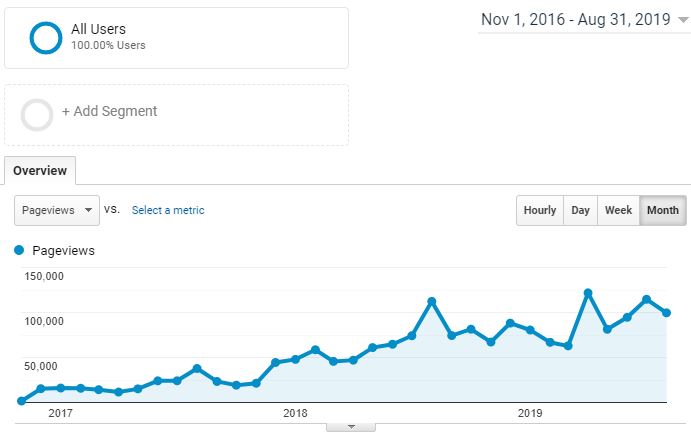
It has been a bumpy ride over the past 34 months, but my traffic has increased significantly year-over-year. During my first 12 months, I received around 15k – 20k pageviews each month. Recently, I’ve received around 100k-130k each month.
Unsurprisingly, as my traffic has increased over time my income has also increased. The following chart shows my monthly blog income since January 2017:
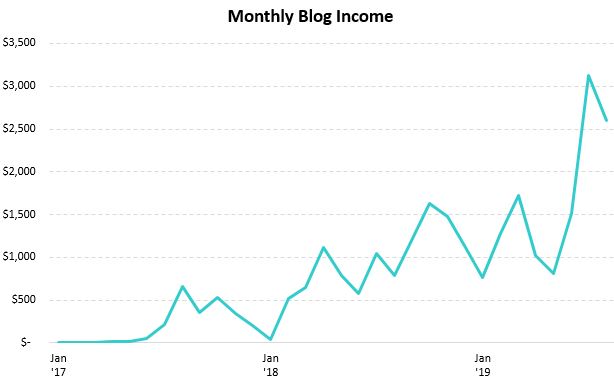
It took a full eight months until I earned my first $100 from blogging. It took 18 months to experience my first $1k/month and just recently in my 33rd month I hit my first $3k/month.
This chart highlights an excellent example of compounding at work: I earned more income from my last two months of blogging than I did from my first 20 months combined. It took a long time for the income flywheel to start spinning, but now that it’s spinning it’s only picking up more and more speed as time goes on.
My monthly expenses tend to hover around $2,000-ish, which means it took a little less than three years for my blogging income to cover all of my living expenses.
What’s fascinating is that I just heard Tommy Griffith mention on an Indie Hackers Podcast that it seems to take about 1,000 days for entrepreneurs to build up their business from scratch to a point where the income they earn from the business is enough to cover their living expenses.
For me, it took roughly (30 days per month * 33 months) 990 days for my online income to cover all of my expenses. Eerily close to 1,000.
How Realistic is it for Most People to Earn a Living as a Full-Time Blogger?
You’ve just seen how long it took me to build up my traffic and income to a point where I was able to quit my day job and pursue blogging full-time. So, naturally the next question is:
“How realistic is it for most people to earn a living as a full-time blogger?”
In other words, how feasible is it for people to replicate my success?
To answer this question, I should first explain the different ways that a blog can receive traffic. Because, after all, the amount of income that a blog earns is highly correlated with the amount of traffic that the blog receives.
There are five main traffic sources for blogs:
Organic Search – A user lands on your blog because they typed a query into Google and found an article from your blog in the search results.
Direct – A user lands on your blog because they directly typed your website URL into a browser.
Social – A user lands on your blog because they clicked on a link to it from a social media channel like Facebook, Twitter, Pinterest, etc.
Referral – A user lands on your blog because they clicked on a link to it from a different website.
Email – A user lands on your blog because they clicked on a link to it from an email.
It’s important to understand the nature of each of these traffic sources. In particular, Direct, Social, Referral, and Email all require constant, steady work to draw people to your site.
By contrast, Organic Search is a highly passive way to receive blog traffic because it involves writing an SEO-optimized article one time that will rank on the front page of Google for specific search phrases and bring in free recurring traffic every single day.
In general, there are three strategies you can pursue to bring in enough traffic to your blog that you can earn a living from it:
1. Focus mostly on organic search traffic. This is the strategy that I have chosen to use for my stats educational website Statology. Every article that I write for that site is SEO-optimized and written with the intention of bringing in traffic solely from people clicking on the site in Google search results.
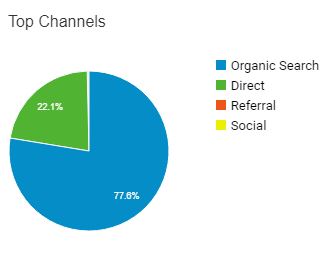
The nice part about this strategy is that I can go weeks (or even months) at a time without writing a new article or updating the site and still receive a steady stream of traffic because so many of the articles I’ve written for that site show up on the first page of Google for various statistics-related search phrases.
If you’re interested in learning SEO yourself, I highly recommend checking out Simple SEO for Bloggers, a course I created specifically for people who are interested in creating passive income sites that bring in traffic with SEO-optimized articles.
2. Focus mostly on direct traffic. Another strategy you can use is to focus mostly on direct traffic, which means writing interesting content that naturally causes readers to come back to your site over and over again because they’re interested in what you’ve written.
One of the most well-known sites that executes this strategy is Slate Star Codex, a site that brings in over one million visitors per month and churns out content on a wide variety of fascinating topics on a regular basis. This site doesn’t really focus on targeting certain keywords with SEO-optimized articles, which can be seen from their traffic sources on Similar Web:
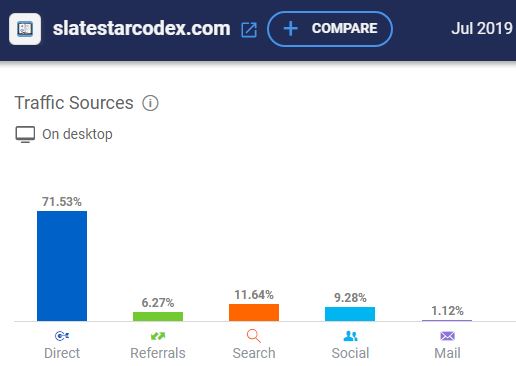
A whopping 71% of their traffic is direct, meaning the bulk of people who visit the site are directly typing the URL into their browser.
There are clear pros and cons of this strategy:
Pro: You don’t have to do any keyword research, think about SEO optimization, or worry about writing enough content to get the article to rank on Google. You can simply write about any topic you’re interested in and publish it to the world.
Con: In order to receive reliable direct traffic over and over again, you have to churn out content on a regular enough basis so that readers know they can type in your URL and be greeted with new content each time they visit your site. Inevitably this means it will probably take longer for you to build up traffic to your site with direct traffic as opposed to organic search traffic because it simply takes longer to build a loyal readership that will visit your site over and over again.
3. Focus on a blended organic search traffic / direct traffic approach: This is the strategy I pursue on Four Pillar Freedom. Some of my articles are SEO-optimized and written with the intention of ranking on Google, while others are written purely because I think the topic is fun or interesting.
Thus, it’s no surprise that my traffic sources are all over the place:
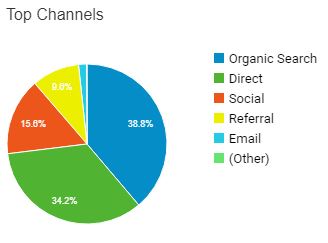
Personally I prefer this approach to blogging because it allows me to bring in free recurring traffic from Google while also giving me the flexibility to write about things that I think are interesting, whether or not those articles bring in recurring search traffic.
If I only wrote SEO-optimized articles, I think I would get bored and eventually experience blogger burnout. But by giving myself the freedom to write about random topics that don’t always rank well on Google, I get to have a bit more fun with the blog.
So, knowing this information, can anyone turn blogging into a full-time living?
Personally I believe the answer is yes, but with a massive caveat: You have to be the type of person who can write (or outsource) one to three articles per week on your blog for at least a year or longer.
Whether you pursue an organic search traffic approach, a direct traffic approach, or a blend of both, blogging is simply a marathon, not a sprint. I haven’t heard of anyone who was able to go from zero to full-time blogging in less than 18 months, and in most cases a more realistic timeline is three years.
Most aspiring bloggers burn out during the first year, and for good reason: It’s hard to see noticeable results during your first year. One glance at my own traffic history confirms this: in month two I got lucky and scored 15,000 pageviews. Fast foward to month 12 and I only received 18,000 pageviews. My first year of blogging traffic was basically flat:

Granted, if I knew more about SEO then I could have increased my traffic much quicker. Even with SEO, though, increasing blog traffic is a serious slog for the first year.
The good news for anyone who is actually patient and can take a multi-year view of blogging is that most of the competition disappears after the first year.
Note: Another strategy to build up blog traffic is through using social media, although this approach is rare and can be tricky. For an excellent example of someone who has effectively done so, check out Ed Latimore.
Should You Start a Blog?
Blogging is an excellent way to make money for me because it matches my personality. I find writing and creating content to be fun.
But not everyone has a personality/unique nature that is suited for blogging.
Some people hate writing and managing websites. If that’s you, it doesn’t make sense to start a blog. You’re better off pursuing some other business that doesn’t rely on creating content. And that’s not a bad thing! Your goal should be to find a field of work that feels like play to you. Once you’ve found that field, you’re more likely to stick with it because it doesn’t feel like work.
So, to wrap up my thoughts: Yes, I believe blogging is an excellent way to earn a full-time living. However, it’s not suitable for everyone. It requires patience, diligence, and endurance. A realistic timeline for going from zero to a full-time living as a blogger is about three years for most people.
- The Ad Revenue Grid - August 6, 2021
- Attract Money by Creating Value for a Specific Audience - July 13, 2021
- The 5-Hour Workday - March 26, 2021
Full Disclosure: Nothing on this site should ever be considered to be advice, research or an invitation to buy or sell any securities, please see my Terms & Conditions page for a full disclaimer.
